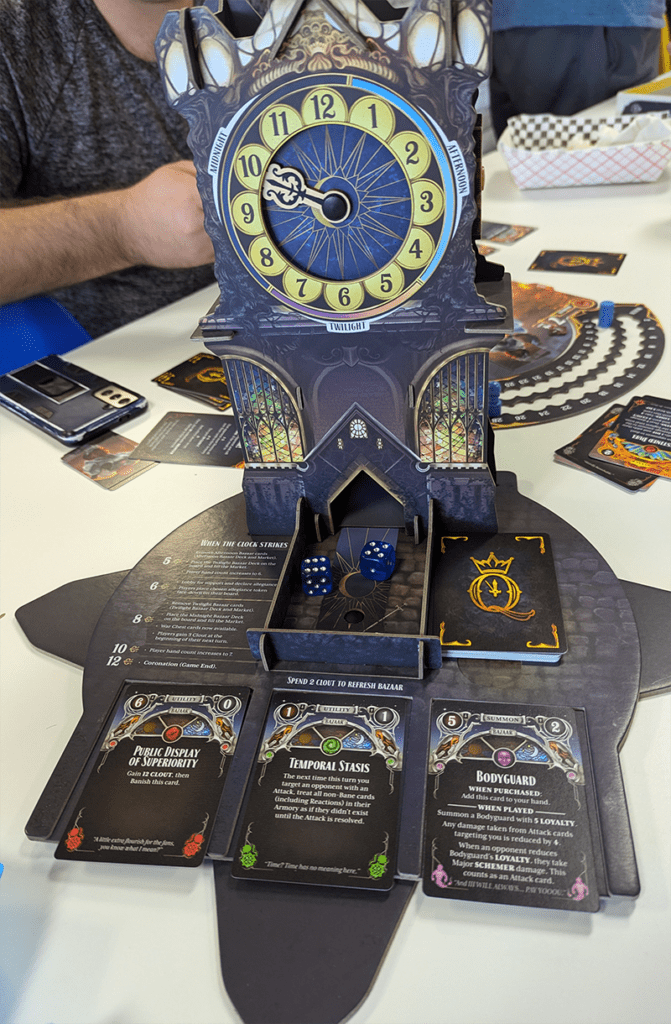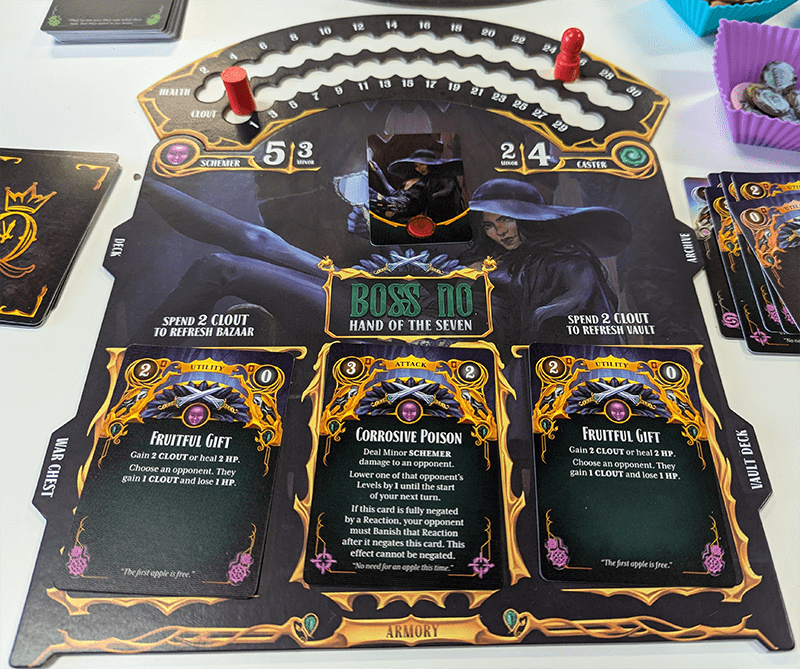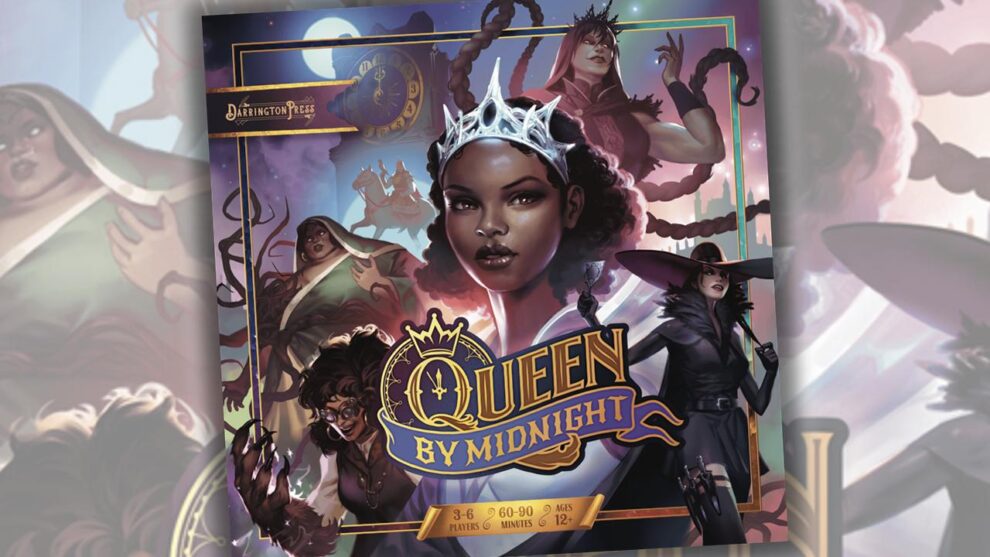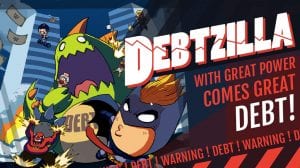Disclosure: Meeple Mountain received a free copy of this product in exchange for an honest, unbiased review. This review is not intended to be an endorsement.
Anyone that has followed my work for the past few years knows that I have a weird affection for the deckbuilding genre. I have been into deckbuilders since the days of Ascension and Dominion, and my first handful of reviews were deckbuilders. Because of this experience, it’s hard for me to get interested in any random deckbuilder.
Queen by Midnight’s hook is that’s a battle royale with a heavy emphasis on diplomacy and a round limit. Yes, a round limit, in a deckbuilder game. Absolutely bonkers proposition that engrossed me enough to play the game and spend some time writing many sentences about it.
The plot is not too hard to understand. The Queen is dead and her last wish is to have a trial by combat with the deadline being midnight. Six princesses show up and you know the ending to this one.
Like many other deckbuilders, the starting deck is full of money cards that you use for the first few rounds to buy new cards to improve your deck. So far that seems quite straightforward, until you look at your options to buy. While this does use Ascensions’ familiar “market row” system where you buy your cards from a row, the similarities end there.
Dealt a Royal Hand
On your Princess playmat, you have a “Vault deck” that acts as your personal market. This Vault Deck is exclusively for your Princess and it is the dynamic that creates the asymmetrical differences between the six Princesses. Not only that, but you also have an option to buy from the Bazaar that acts like a “common” market for everyone else. You can buy as many cards as you have money for, mixing common cards with your own princess-specific cards.
To make this even more interesting, the common deck changes throughout the game. At the start it’s the morning deck, focusing on defensive options and ways to gain more “clout,” this game’s currency. Later, the afternoon deck makes violence a more common option, and is followed by the evening deck where cards are designed to cause huge shifts between players on each round.
It doesn’t end there. The game comes with a beautifully crafted clocktower that acts as a round tracker, dice tower, and a rotating lazy susan for the Bazaar deck. It also has a player aid that tells you what happens during specific turns. Besides the changing of the Bazaar deck, your hand limit increases over time. Perhaps the most important part of all of this is the 6th hour.

Raising the Stakes
During the special hour, players set aside their decks for some diplomatic talk. This key part of the game has everyone discussing who they’d back if they get eliminated. If that happens, the knocked-out player becomes an inner circle member to their chosen ally. As a member, they don’t use the deck anymore, instead it’s supplanted by a list of two powerful abilities specific to their Princess. It’s a neat twist—if that ally wins, the member shares in the victory. Does it work? Somewhat.
As for the cards themselves, there’s not too much to write home about. Attack cards do exactly as you would expect. Reaction cards are defensive cards that you play face down that are quite similar to Yu-Gi-Oh’s Trap cards. Boons and Banes are fancy ways of saying buffs and debuffs that you can play on yourself or others. Summons are like a buff that other players can attack. Utility cards are the simple one to understand, as you simply follow the text and discard it afterwards.
The game ends under two conditions. If there is only one Princess standing, they immediately win. Most of the time, it’s going to end by having the clock strike 12. Whoever has the most points, meaning their clout and health point total, is the winner.
The Midnight Hour
As someone who is well-versed in combat deckbuilders, the proposition Queen by Midnight offers sounds like the sweetest deal when what’s mostly out there is sour. The only combat deckbuilder that I truly enjoyed was Eternal: Chronicles of the Throne, and that’s because it was one of the few combat deckbuilders that didn’t rely on excessive math. Queen by Midnight was close to hitting that mark, yet after playing this game with all six princesses, I can’t help shake the feeling that this is undercooked.
The first evidence of this is the deckbuilding itself. Everyone has the exact same deck providing them clout to spend to buy cards or hoard for future turns. While this doesn’t sound bad in theory, the question is why did it have to be designed this way? This is a deckbuilder where players have their own unique set of cards to buy, so why put some of those cards in the starter deck to speed things along?
Come to think of it, Queen by Midnight is an extremely slow game.
The game’s opening half focuses on building your deck, since you start with limited offensive options. Everyone begins with a strong defensive card that can counter incoming attacks, which slows things down. This setup would be fine, except most cards are loaded with text. Reading them feels a bit like poring over dense literature, which can bog down the pace.
A Full House of Text
These cards are text-only affairs—no artwork in sight. This design choice means players who struggle to process all this information will slow down the game for everyone. The creators of Queen by Midnight seem to recognize this issue, as they reduce the number of rounds for larger groups. Speaking of group size, it’s best to cap it at four players. Any more than that and you’re looking at a marathon session that could easily stretch beyond two hours.
Because of this weird pacing, it also impacts the 6th hour where everyone is supposed to talk, except there isn’t much to talk about. You didn’t deal any significant damage and the only piece of information you have is what cards everyone bought. I get what the game is going for, since being a Queen does require diplomatic talks, yet there must be some foundations to discuss and Queen by Midnight doesn’t provide enough to work with.
This isn’t to downplay the importance of the inner circle members. I like this portion quite a bit since it does solve potential player elimination issues that battle royale games tend to have. At a surface level, it’s a consolation prize for a losing player. However, once you realize the power of these special actions, this isn’t the case. The inner circle member is less of a consolation prize and more of a deterrent to not reduce a player’s health points to zero. It’s a Pandora’s box where you have no idea what the consequences are once you stomp your foot into your opponent’s face for one last time.
I also cannot help but praise the six princesses. Besides sporting some beautiful artwork, they all play differently with some of them having their own tokens and systems to wrestle with. One princess has to switch between Trance and Awake forms to generate Prophecy tokens for more power. One has lash tokens to beat their opponents, while another excessively uses dice for their random outcomes. To exacerbate the differences even further, each Princess will have two out of the three classes, and those classes limit what cards they can purchase from the Bazaar.

Folding Early
But I also can’t ignore that the game’s rhythm is a bit off-kilter. You get flashes of excitement here and there, but for something billed as a battle royale, it rarely delivers on that promise. Out of all our playthroughs, only one turned into the all-out brawl we were expecting. The main culprits? Limited chances to actually attack other players, coupled with an abundance of defensive cards that constantly diffuse the tension. It’s like gearing up for a fight, only to spend most of your time dodging and weaving.
Players typically gang up on whoever’s in the lead. The strategy, then, boils down to this: one player burns their influence to force another player to waste their hidden defensive cards. Then, the next player swoops in to land the real damage. This pattern keeps going round and round, with bigger hits as stronger cards show up in the market later on. Sure, there are some potent, character-specific cards in the War Chest, but they usually arrive too late to really shake things up.
Queen by Midnight spotlights an intriguing concept in the realm of deckbuilding games, blending elements of battle royale and diplomacy within a time-constrained framework. However, the game’s pacing issues, awkward metagame, and text-heavy design often overshadow its daring features. Despite its flaws, Queen by Midnight might find an audience among patient players hungry for something different. Ultimately, it has potential but doesn’t quite ascend to the throne of must-play deckbuilders.












Add Comment